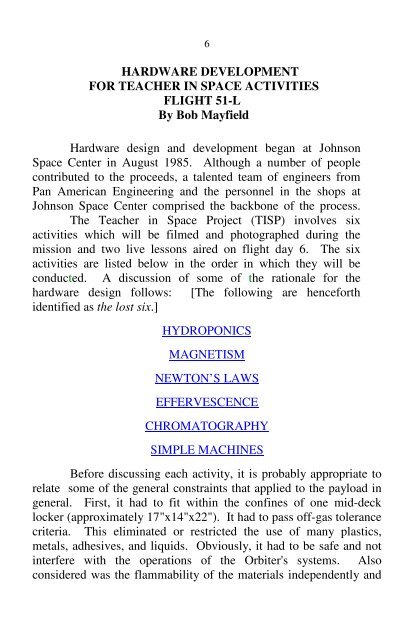CHALLENGER'S LOST LESSONS - ER - NASA
CHALLENGER'S LOST LESSONS - ER - NASA
CHALLENGER'S LOST LESSONS - ER - NASA
You also want an ePaper? Increase the reach of your titles
YUMPU automatically turns print PDFs into web optimized ePapers that Google loves.
6HARDWARE DEVELOPMENTFOR TEACH<strong>ER</strong> IN SPACE ACTIVITIESFLIGHT 51-LBy Bob MayfieldHardware design and development began at JohnsonSpace Center in August 1985. Although a number of peoplecontributed to the proceeds, a talented team of engineers fromPan American Engineering and the personnel in the shops atJohnson Space Center comprised the backbone of the process.The Teacher in Space Project (TISP) involves sixactivities which will be filmed and photographed during themission and two live lessons aired on flight day 6. The sixactivities are listed below in the order in which they will beconducted. A discussion of some of the rationale for thehardware design follows: [The following are henceforthidentified as the lost six.]HYDROPONICSMAGNETISMNEWTON’S LAWSEFF<strong>ER</strong>VESCENCECHROMATOGRAPHYSIMPLE MACHINESBefore discussing each activity, it is probably appropriate torelate some of the general constraints that applied to the payload ingeneral. First, it had to fit within the confines of one mid-decklocker (approximately 17"x14"x22"). It had to pass off-gas tolerancecriteria. This eliminated or restricted the use of many plastics,metals, adhesives, and liquids. Obviously, it had to be safe and notinterfere with the operations of the Orbiter's systems. Alsoconsidered was the flammability of the materials independently and
















